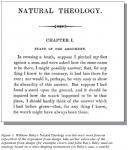"There cannot be design without a designer."
Arguments involving timekeeping instruments have been common throughout the history of the creationism/evolution controversy. For example, in 45 BCE Roman philosopher and orator Marcus Tullius Cicero (106–43 BCE) — an early advocate of "intelligent design" (ID) — claimed in The Nature of the Gods that "when you see a sundial or a water–clock, you see that it tells the time by design and not by chance. How then can you imagine that the universe as a whole is devoid of purpose and intelligence?"
In 1681, Thomas Burnet's (1636–1715) The Sacred Theory of the Earth, which founded scriptural geology (by trying to reconcile Scripture with geology), relegated God to the part of a playwright instead of a direct actor. Burnet used an analogy involving a clockmaker to argue that God's role in nature is indirect:"We think him a better artist that makes a clock that strikes regularly every hour from the springs and wheels which he puts in the work, than he that hath so made his clock that he must put his finger to it every hour to make it strike."
A decade later, John Ray — whose work set a pattern for European science for more than almost two centuries — discussed the relationship between God and nature in The Wisdom of God Manifested in the Works of Creation. Ray, who believed that adaptations are permanent traits designed by God, claimed that organisms have no history; they have always been the same, lived in the same places, and done the same things as when they were first created. Ray argued that a clock shows evidence of a designer, and since nature is more perfect than a clock, then nature must also include a master designer.
In 1696, English clergyman and natural philosopher William Derham's (1657–1735) The Artificial Clockmaker presented a teleological argument for the existence of God. In 1754, German philosopher and deist Hermann Samuel Reimarus's (1694–1768) Principal Truths of Natural Religion rebuffed Epicurean criticisms of ID. Reimarus transformed Ray's metaphor involving a clock into one involving a watch, thereby setting the stage for the well known argument of William Paley, the most famous advocate of ID.
William Paley was born in Peterborough, England in July 1743. Paley graduated from Cambridge first in his class in 1763, became a deacon in 1765, and was appointed assistant curate in Greenwich. Paley taught at Cambridge for ten years. He was ordained in 1767 (after earlier earning an MA), and the remainder of his clerical career included successively more influential positions within the Anglican Church. Paley opposed slavery and advocated prison reform, and as a philosopher, was a utilitarian, believing that humans act morally to increase their overall level of happiness. In 1776, Paley married Jane Hewitt, with whom he had eight children.
Paley was a popular preacher and one of England's most important theologians of his generation. He published his Cambridge lectures in The Principles of Moral and Political Philosophy (1785), which outlined his utilitarianism and was used as a textbook at Cambridge for many years. This was followed by A View of the Evidences of Christianity (1794), which was a response to David Hume's skepticism of religion and, in particular, Hume's dismissal of miracles. But Paley's best-known book, and the last before his death, was Natural Theology; or, Evidences of the Existence and Attributes of the Deity, Collected from the Appearances of Nature (1802).

In Natural Theology, Paley — one of the most admired clerics in the English–speaking world — argued that God could be understood by studying the natural world. Natural Theology begins with the famous metaphor of God as watchmaker (Figure 1). Paley argued that the only rational conclusion is that the watch "must have had" a designer. Much of Natural Theology discusses examples of purported design in nature, with many drawn from Paley's own observations, and likely to be familiar — and therefore persuasive — to readers. Paley's designer was his watchmaking God.
Charles Darwin read Natural Theology while at Cambridge, and was encouraged by his instructors John Henslow and Adam Sedgwick to accept Paley's perspective. Darwin recalled that Paley's work, including Natural Theology, "was the only part of the academical course which, as I then felt and as I still believe, was of the least use to me in the education of my mind." When Darwin boarded the Beagle, he accepted design in nature. However, after discovering natural selection, he felt differently: "The old argument of design in nature, as given by Paley, which formerly seemed to me so conclusive, fails, now that the law of natural selection has been discovered."
Virtually all biologists have similarly rejected Paley's argument. The most famous of these refutations is Richard Dawkins's The Blind Watchmaker (1986), whose title refers to Paley's metaphor. Dawkins agrees that there is a watchmaker, but otherwise concludes that Paley is "gloriously and utterly wrong." The watchmaker for Dawkins (and for contemporary biology) is natural selection. Biologists view the evolution of complexity and apparent design, therefore, simply as the result of the cumulative process of repeated generations of differential reproduction. Dawkins's book motivated Phillip Johnson to write Darwin On Trial and to become active in the ID movement. Although proponents of ID claim that their premises differ from Paley's, and, unlike Paley, do not specify who or what the designer is, most evolutionary biologists see ID as a version of Paley's arguments updated to account for advances in our understanding of biology.
Soon after finishing Natural Theology, Paley suspected that his death was imminent, and he assembled his sermons to be published posthumously and given to anyone "likely to read them". Paley died on May 25, 1805, and was buried in the Carlisle Cathedral, next to his wife.
